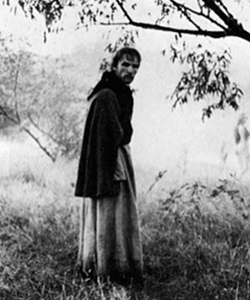Review: Midnight in the Garden of Good and Evil (1997)
Operating solely from behind the camera for only the third time in his directorial career, Midnight in the Garden of Good and Evil saw Eastwood leave acting behind to focus on recreating the world of 1980s Georgia. An adaptation of John Berendt’s bestselling non-fiction book, the film retells one of the state’s most famous legal battles.
John Kelso, a Town & Country reporter assigned to cover the famous annual Christmas party of eccentric antiques dealer Jim Williams, uncovers the oddity of the Georgian upper class when a local young rapscallion is discovered shot to death in Williams’ office. Staying on to cover the ensuing trial and Williams’ defence, Kelso becomes embroiled in the weird world of Savannah.
A helicopter shot glides over the Savannah of the American Southeast as Eastwood hones in on his setting, bringing us to rest in an unassuming graveyard adjoining a park. Seated on a bench, a strange woman looks up to the sky to greet the arrival of an overflying plane, cackling maniacally with an unsettling prescience of what is to come. The town of Savannah is steeped in otherworldly oddity as Kelso quickly discovers, a variety of unusual characters populating the story and contributing increasingly bizarre subplots and side-stories to the primary criminal trial narrative. Eastwood travels a little outside his comfort zone, the eerie supernaturalism of the town and its populace unlike anything he has dealt in before, save perhaps the spiritual elements of High Plains Drifter. From the graveyard ceremonies of the spiritualist Minerva to the eccentric drag queen The Lady Chablis, Midnight in the Garden of Good and Evil is an exercise in outlandishness. Its range of bizarre characters frequently derail the narrative progress, lending excess quantities of time to the aforementioned drag queen and to Kelso’s courtship with an aspiring singer. The focus of the film ought to remain on Williams, but he often disappears for long stretches at a time, prompting us to almost forget that his criminal trial is on-going and leaving us struggling to recall his situation when he finally re-emerges. With a 150 minute runtime, the film is helplessly overwrought, the sprawling expanse of narrative threads Eastwood attempts to tie neatly together left to diverge in all manner of directions. This is an ill-disciplined story, its transition in script from factual account to fictionalized narrative falling prey to a plethora of distracting problems. We spend far too much time in the company of ultimately unimportant characters; the body of the film should rest with Williams and his story, but this is instead left until the final half hour to explore in any depth whatsoever. Kelso, for all his affability, is a weak protagonist, his thinly written love interest an underdeveloped attempt at adding weight to his character. John Cusack does his best with the material, but the result is less than memorable. As Williams, Spacey is the film’s finest asset, his accent pitch-perfect and his mannerisms drawing us into his character’s story, poorly told though it is. His final scene might be the film’s best, a confrontation with the ghost of his victim, and the overdue arrival of the raw emotion in which the film so evidently lacks until this point.
Crippled by the added weight of far too many supporting characters and subplots, Midnight in the Garden of Good and Evil falls apart almost before it begins. Though blessed with a fine duo at its centre, the eventually irritating nature of its indulgence in supernaturalism and its patent lack of an emotional core never allow it the chance to become anything more than a sprawling mess.
















 Review: Everything Must Go (2011)
Review: Everything Must Go (2011) Review: Batman Year One (2011)
Review: Batman Year One (2011) Review: Real Steel (2011)
Review: Real Steel (2011) Review: Flight of the Red Balloon (2007)
Review: Flight of the Red Balloon (2007) Review: Midnight in the Garden of Good and Evil (1997)
Review: Midnight in the Garden of Good and Evil (1997)


